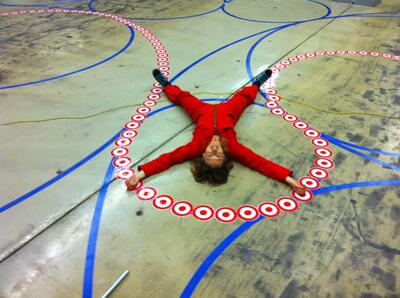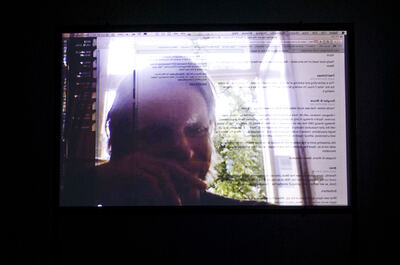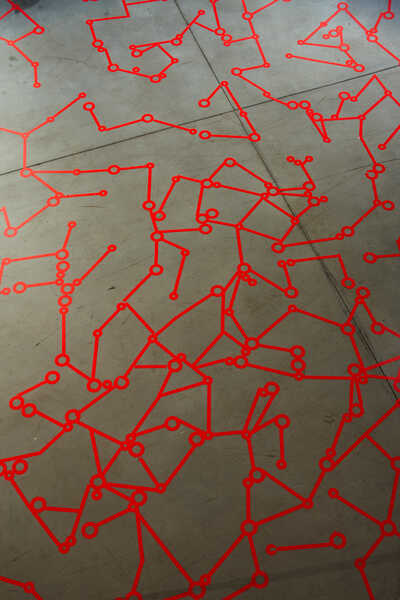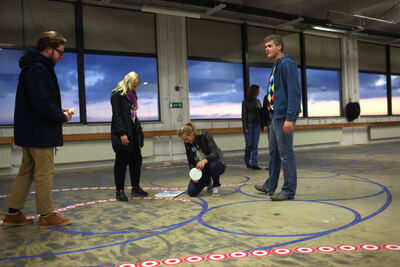Luna Maurer — Playful Systems
Luna Maurer is a designer and artist working on human input in structured processes.

www.poly-luna.com
www.poly-xelor.com
www.conditionaldesign.org
Luna Maurer is a designer and artist working on human input in structured processes.

www.poly-luna.com
www.poly-xelor.com
www.conditionaldesign.org
Conversation as a play with rules: Three short dialogues between Luna Maurer and Andreas Zangger on the interaction of humans and machines, on designing systems, and on participation of the users.
Conversation as a play with rules: Three short dialogues between Luna Maurer and Andreas Zangger on the interaction of humans and machines, on designing systems, and on participation of the users.
In these dialogue we try to bring in the questions and experiences arising in the context of our work. Luna Maurer is a designer and artist working in the field of digital media. Andreas Zangger is historian of science and of transnational networks.
The work of Luna Maurer serves as a bracket for the dialogue.
The dialogues are inspired by the idea of conditional design that is at the centre of Luna Maurer's work. They are based on chats on Skype. There were rules for the chat, e.g. we had to wait for an answer. The speed of the chat was thus utterly reduced. Afterwards they were edited and grouped by topics. Each of the dialogues has a general topic: the first deals with the relationship of humans and machines, the second on designing system and the idea of constraints and freedom in the process, and the third about users and the intelligence of the crowd. Some of the mentioned projects of Luna Maurer are presented separately.
We wrote the manifesto on our weekly meetings at Luna's Kitchen table in order to frame our ideas and fascinations.
We wrote the manifesto on our weekly meetings at Luna's Kitchen table in order to frame our ideas and fascinations.
Through the influence of the media and technology on our world, our lives are increasingly characterized by speed and constant change. We live in a dynamic, data-driven society that is continually sparking new forms of human interaction and social contexts. Instead of romanticizing the past, we want to adapt our way of working to coincide with these developments, and we want our work to reflect the here and now. We want to embrace the complexity of this landscape, deliver insight into it and show both its beauty and its shortcomings.
Our work focuses on processes rather than products: things that adapt to their environment, emphasize change and show difference.
Instead of operating under the terms of Graphic Design, Interaction Design, Media Art or Sound Design, we want to introduce Conditional Design as a term that refers to our approach rather than our chosen media. We conduct our activities using the methods of philosophers, engineers, inventors and mystics.
Process
The process is the product.
The most important aspects of a process are time, relationship and change.
The process produces formations rather than forms.
We search for unexpected but correlative, emergent patterns.
Even though a process has the appearance of objectivity, we realize the fact that it stems from subjective intentions.
Logic
Logic is our tool.
Logic is our method for accentuating the ungraspable. A clear and logical setting emphasizes that which does not seem to fit within it.
We use logic to design the conditions through which the process can take place.
Design conditions using intelligible rules.
Avoid arbitrary randomness. Difference should have a reason.
Use rules as constraints. Constraints sharpen the perspective on the process and stimulate play within the limitations.
Input
The input is our material.
Input engages logic and activates and influences the process.
Input should come from our external and complex environment: nature, society and its human interactions.
__
By: Luna Maurer, Edo Paulus, Jonathan Puckey, Roel Wouters.
How do machines affect our daily lives? How do we adapt our lives to the machines? A short dialogue on the interaction between humans and machines and the project 'Laptop Reflections' by Luna Maurer, Edo Paulus, Jonathan Puckey and Roel Wouters.
How do machines affect our daily lives? How do we adapt our lives to the machines? A short dialogue on the interaction between humans and machines and the project 'Laptop Reflections' by Luna Maurer, Edo Paulus, Jonathan Puckey and Roel Wouters.
LM: Can a machine talk?
AZ: In the early days gramophones were called 'talking machines'. Nowadays you could ask the question the other way round. Can humans talk? You see people walking around in the streets and you think: another one who is having a monologue. But he has his headset on. He is man-machine hybrid communicating with someone in world out there. We are all cyborgs.
LM: I see, you mean the machine becomes an extension in order to amplify our senses. But isn't it also that the machine has its own logic. We use the tools, but the tools want us to behave in a certain way? So the tools use us.
AZ: The discussion around technology often revolves around the question if technology liberates us or enslaves us. Humans still act, but machines structure our daily lives through and through. Modern humans actually can't be thought of without machines, they could not survive. So we are man-machine-man-machine-networks.
LM: I find it exciting if the machine - or even in a wider sense a system - delivers something to which I need to react to as a person: the resistance of the system, let's say, people and systems in exchange with friction.
AZ: This has to be a very productive friction. When a machine does not do what I want it to, I get either bored or angry.
LM: Angry is better than bored. Then, at least, it does something to you. But I mean that it should lead to new developments: You intended to do something but the machine (system/environment that you act in) formed your action into something else upon which you have to react again. It is more stimulating, than if it does everything exactly as you want. Many designers embrace the mistakes a machine makes and use them as creative input. In this man-machine relationship needs to be resistance in order to evolve.
AZ: Then you are assigning the machine an interesting role here. Most people think that machines are there to function.
LM: Even when it functions I have a relationship with the machine. A lot of times I adapt my behaviour maybe even without noticing. I get excited about what the machine does, it captures me or I take care of it. I can do that only when I respect the machine as such. A project that illustrates this thought is 'Laptop Reflections' shown in the Graphic Design Museum in Breda. Here the machine becomes an actor, a sort of an omnipresent eye observing our behaviour with itself. Because we are conscious of this observation, we react upon it. There is a constant interaction between us and our laptops.
AZ: I find there is an intriguing twist to that project. On the one side you create this 'big brother' setting, this eye generating thousands of pictures of you and what you do. On the other side that doesn’t seem to be intimidating. Your laptops are not HAL from Stanley Kubricks «2001: A Space Odyssey», a computer that takes over and finally destroys the humans. Instead the visitors see an almost intimate relationship between the four of you and their laptops. You see situations from early morning mail checking until late-night movie watching. There is a smooth interaction and an almost tender relationship.
For such a relationship computers not only have to adapt to humans, but humans also slowly adapt to their computers.
LM: That's one aspect in 'Laptop Reflections'. But our approach comes more from designing systems. We design systems with rules. When humans interact with the system these rules constrain what they can do. Systems have their own logic. The more complex they are, the more it feels as if the system resists to human interaction. There is a friction, almost as if the machine has its own will.
That's what I was pointing at, when I provocatively asked, if a machine can talk. I didn't mean the capacity of producing speech, but rather the possibility of expressing itself by complexity.

Conditional Design are Luna Maurer, Edo Paulus, Jonathan Puckey and Roel Wouters. All four of us are working with their laptops on a daily basis. We wrote a script that captured our portraits via the webcam on our laptops and made simultaneously screenshots of the desktops every 5 minutes. These pictures show our behaviour with the computer during one whole year.
The enormous archive of images is revealed in the form of 5 videos, each lasting 3 hours 27 mins, a wall print, a newspaper and the website www.laptopreflections.org. The images used span the period from 1 April to 16 December 2009.
The second dialogue deals with the designing of systems or plays, as well as the constraints and the freedom they need to work.
The second dialogue deals with the designing of systems or plays, as well as the constraints and the freedom they need to work.
AZ: In the last section you were talking about the resistance of the system or the machine. That reminds me of sociology of knowledge, where resistance is an important concept for understanding the development of knowledge. Ludwik Fleck talks about the situation when some evidence doesn't fit the theory: either it is just considered as noise or the group of scientists accepts it as a sign of resistance to their theory. Only then it can generate new thinking. And also for Bruno Latour the resistance of objects – he would call them actants – is crucial for the building of socio-technical networks. I don't want to go in details, but ask you: what is your interest in resistance?
LM: When a system has no boundaries, no limitations, it gets boring soon. The friction and resistance instead lead to engagement. We start to play with a system in order to find our freedom within the limits it sets. Look for instance at twitter: the limitation of 140 characters fuels the creativity of people and sharpens their message.
When I design I try to balance freedom and constraints. You could say that resistance goes along with constraints and freedom allows space for the unexpected. That is the reason why I am less interested in designing fixed shapes. I prefer to design machines, and I am more curious to discover a process that unfolds once I press the 'play' button and the machine starts running. With machine I mean all kinds of systems: it can even be a physical game.
AZ: I guess the idea behind these machines must be more that of a children's play with no particular goal than a game where you can win and loose, isn't it?
LM: Right, my work revolves much around the idea of play. You have rules, you have participants and you have unexpected developments. This dialogue is similar in a way. One reacts upon another, within given boundaries, and it can go anywhere within the given framework. There are so many paths and junctions where to go, and we will just use one, although there are many possibilities. This is one of many possible dialogues.
AZ: In history we often talk about contingency. That means that the development of things is neither predetermined, according to rules of nature and society, nor is it totally random and unpredictable. When you look back you can see causes and effects. It can make sense, although you could not have been sure about the outcome beforehand. History is an open structure, it can be influenced, there are millions of interactions going on which have effects on the course of events.
LM: Some of my projects also focus on the idea of many possible outcomes, and I actually like those the most. I try to design systems that are open to influence from outside, the real world. In our Conditional Design Manifesto we stated this importance of the input from outside, mostly human interaction.
If we are talking about our dialogue or play: we, our brains are the real world – the undefined, undetermined and surprising input. That also is the intriguing part of participation: when people are part of the system, you never know what to expect.
AZ: Do you like the design you are creating in your plays?
LM: When I first saw the pictures of Red Fungus I was even a bit disappointed. The rules I set out were quite tight, but still gave a lot of freedom to play. But what I saw was only nodes and edges, people glued a network structure with the stickers. This was the most obvious shape. Only later on when it evolved more and more it got very fascinating. The stickers were glued all over the floor and walls and even on top pf other art works, almost hijacking them. Then you also saw more variety in what people made with these four stickers they got. I don't know what is more intriguing: the patterns or the idea that so many people are part of the piece and the power that it expresses.
AZ: But I don't think its about the power of the masses, like for instance in the films of Leni Riefenstahl. It's rather a fascination for the multitude: every statement is singular and unique. It can express individuality. But together they form a bigger picture.

Red Fungus is a follow up to Blue Fungus, but with different rules. Visitors to the exhibition are given a sheet of four stickers upon entering the museum. They are then asked to affix these stickers on the exhibition floor, according to a simple set of rules.
Red Fungus is a follow up to Blue Fungus, but with different rules. Visitors to the exhibition are given a sheet of four stickers upon entering the museum. They are then asked to affix these stickers on the exhibition floor, according to a simple set of rules.

Having only four stickers consisting of basic shapes – two sizes of lines and circles – limits the scope of expression. It is exactly these limitations that will force the visitors to act like a machine, though one with a bit of creativity. While each visitor executes only a simple task, the repetition of these tasks, combined with the collaboration of other visitors, will lead to a more complex image. The freedom of direction and positioning of the sticker (within the limits of the rules) confronts the visitors with the impossibility of making an arbitrary choice. Patterns emerge because people will observe what others previously have done and react accordingly. So, ultimately the visitors work as a collective in the creation of an image. In this way, Red Fungus investigates the relation of emergence and (un)conscious human action.
Rules:
1 - Connect the stickers to the ones already affixed to the floor.
2 - Elements can be connected anywhere but may not cross over each other.
3 - Open line-ends are not allowed: connect them to other lines or to a circle.
Concept of the exhibition:
Before the background of unforeseen global processes, credit crash and climate change, the exhibition el proceso como paradigma researches the nature of processes and self organising, processual systems on a cultural level and in the arts. el proceso como paradigma puts forward the idea that today processes have become one of the major paradigms and creative strategies in contemporary art and design across the disciplines. The show reveals the elementary shift from a culture based on the concept of manifestation and the final product to a culture of process resulting from a networked society. Consequently, the show introduces a new understanding of process-based art which goes beyond previous definitions. el proceso como paradigma suggests that the new process-based art is the art of the 21st century.
The third dialogue deals with the collective processes, mechanical turk and the intelligence of the crowd.
The third dialogue deals with the collective processes, mechanical turk and the intelligence of the crowd.
AZ: There is an interesting friction between the idea of design and the input from outside. Design is about creativity, but it is also about control. Why do you choose not putting the stickers yourself on the floor? You would have much more control then.
LM: I could not care less to stick stickers on the floor. The joy is to see what happens when you create a setting where a lot of people - that don't even know each other - become part of the same system, use the same tool or material. I look for situations that one person couldn't have made. But I am also interested in the dynamics. It is so overwhelming to see these big pieces of fungus, that spread, with no logic or with a lot of logic - that is to the viewer to decide.
AZ: And how do make people your allies?
LM: As I said before: limitations stimulate people. They try to create a message within the little freedom they have. If the visitors get to much freedom, they would do completely non-related things. But if you have too little freedom it gets boring as well. It was interesting to hear the remarks from people at the project in Flux-S from 'Tape on floor 4': We drew big circles on the floor following certain rules. The visitors had their own round stickers and could stick them on the circle lines to make one big snake. Only on junctions someone could decide in what direction to go. Quite quickly it became clear that there is too little freedom for decision making. That lead to little engagement.
AZ: Do you think that the presence of the inventor of the Red Fungus influenced people, so that they did not think so much what they want to do, but what they thought was 'meant' to do and that they could develop their ideas more freely, when nobody was around?
LM: Exactly. People think - what did the artist expect me to do. A system works best, once people take it over and think of it as their own tool or system. Maybe Facebook is an example. Nobody thinks of the inventor of Facebook when using it. Instead it evolves into dimensions no one foresees. People have to embrace it.
AZ: But nowadays people are asked to participate everywhere. Caroline Nevejans claims that participation almost became meaningless these days; there is a participation overload.
This has to do with the democratization of our societies. A few centuries back only a tiny elite was meant to reflect about the world, to say things with authority, or to represent it in pieces of art. Nowadays everybody can say something about the world or make representations about the world. The arrival of the internet promotes this development massively.
LM: I find it fantastic. The only dilemma is the question, whether there isn’t the need of some direction or guidance. So in fact, that means, that the designer of the system has responsibility of designing systems of such a sort, that it stimulates creativity and intelligence in people.
AZ: You talk about guidance. Do you actually want everybody to become an artist or are you just able to collaborate with crowds, because people are used to produce little public statements all the time?
LM: I like it, when people are stimulated to ask themselves questions, to reflect upon our society and not just adapt pre-existing ideas. Participation is sometimes the method to achieve this goal. I don’t want to emphasize my personal message. Instead I find it fascinating to see what emerges when a crowd takes part. A lot of tiny elements creating a formation together is more interesting than one fix shape. Everybody delivers a bit of intelligence and together the whole is something else.
Mechanical Turk of Amazon is a good practical example for that. This is a crowd sourcing tool: people act together as one big machine with everyone as a small intelligent part. Maybe this isn’t the sort of participation which we are talking about. Which has more to do with engagement, and that you make the tools your own and you are able to create with intelligence.
AZ: Now the concept of intelligence is interesting. Are the people using the tool intelligent or does the tool have to be intelligent in order that people actually use it?
LM: Maybe both have to be intelligent: the people use it, use their creativity to work with it and the tool itself has to be simple yet intelligent. This is maybe comparable to the aesthetic concepts of simplicity in science. Although it is very simple to use, it is possible to gain a big variety of results and it leaves space for personal expression.
Simple rules, complex outcome, that’s the ultimate goal.

The 1200 m² on the 4th floor of the SBP-building at the Strijp-S terrain acted as the surface for our playing field. The Court-Line™ Tape Machine served as our pen.
We were fascinated by the abstract beauty of lines on the gym floor. Usually these lines define the boundaries of the playing field. We designed a game that creates its boundaries through playing.
The visitors were invited to play with us but they had an absolute minimum amount of freedom. They had to make a snake with stickers as long as possible. Only a few of them were able to change the direction of the game and only a handful were responsible for the crucial decisions that could have ended it. Most of the visitors were only able to feed the snake.
The 1200 m² on the 4th floor of the SBP-building at the Strijp-S terrain acted as the surface for our playing field. The Court-Line™ Tape Machine served as our pen.
We were fascinated by the abstract beauty of lines on the gym floor. Usually these lines define the boundaries of the playing field. We designed a game that creates its boundaries through playing.
The visitors were invited to play with us but they had an absolute minimum amount of freedom. They had to make a snake with stickers as long as possible. Only a few of them were able to change the direction of the game and only a handful were responsible for the crucial decisions that could have ended it. Most of the visitors were only able to feed the snake.

Your Instructions (visitors)
Make a snake.
1. Take a sticker.
2. Place your sticker at the end of the snake on the blue circle line.
3. On a junction, choose the path that has the best prospectus.
Pssst! The snake may not eat its own tail.
Our Instructions (Conditional Design Team)
Provide a path for the snake.
1. Draw the biggest possible circle
2. Use green tape to mark the center of the circles.
3. Each new circle should touch the former circle but may not include the center point of another circle.